Car Tech A to Z: D is for diesel, dampers and more...
The letter D in our A to Z of car tech explains diesel, dampers, dynamic drive and designers
The technology contained within the modern motor car can be both fascinating but slightly baffling nowadays. Most of such technology exists to make our cars safer, more efficient and just better than ever to drive.
But some of it can be quite confusing for the average motorist, so in this A to Z series we will attempt to unravel the mystery of technology that is the modern motor car. This week, we’re visiting the letter D…
D is for…diesel. Diesel engines work by fuel being injected into a cylinder’s combustion chamber, which is then compressed to such a degree that it causes a small explosion. This creates propulsion.
• The best diesel cars of 2017
In a petrol engine a spark plug is required to ignite the fuel but in a diesel engine only the act of compressing the air itself within the cylinder is needed to create energy.
The diesel engine was invented by German engineer Rudolf Diesel in 1892, and is still used widely today. Modern diesel engines are highly sophisticated, with some using turbochargers, and although they’re much more efficient than those of yesteryear, they still employ the same fundamental principles of ignition as those invented by Rudolph Diesel.
D is for…dampers. Also known as shock absorbers, dampers help absorb the shocks encountered by the tyres as a vehicle moves along the road. A damper converts the energy of this shock into another form of energy, usually heat. Most dampers work hydraulically but some use air or electronics to aid the speed and style of response to that initial shock.
D is for…dynamic drive. These days sportier cars come with some form of dynamic drive as standard. This enables a driver to alter a car’s dynamic personality on the move.
This is achieved by altering various things - the mapping for the throttle and gearbox, the weight and feel of the steering, the severity of response from the electronic stability program, the speed and severity of response from the rear differential and, most vitally of all, the stiffness of the dampers.
In all wheel-drive cars, the delivery of the four-wheel drive system can also be altered to make the car feel more or less like a rear drive car, depending on whatever a driver wants.
Ultimately, dynamic drive enables drivers to tune their cars in a way that – 20 years ago – would have required a complete change of vehicle, rather than just the press of a button or two.
D is for…designers. The work of the car designer has become both harder and more simple in recent years. Harder because the emphasis on design has never been more keenly scrutinised than it is today. If a car looks great but drives moderately, it will more than likely succeed. If it drives like a dream but looks plain, it will almost certainly fail.
But the role and methodology of the car designer is much easier nowadays because of computers. Just about every modern road car is designed first on a computer, using computer aided design programs.
Even so, a truly talented car designer can still make a huge difference to a brand’s identity. And therefore its success. After the CEO you could easily argue that the next most important person in any car company is its chief designer.
Next, the letter E…

Find a car with the experts


